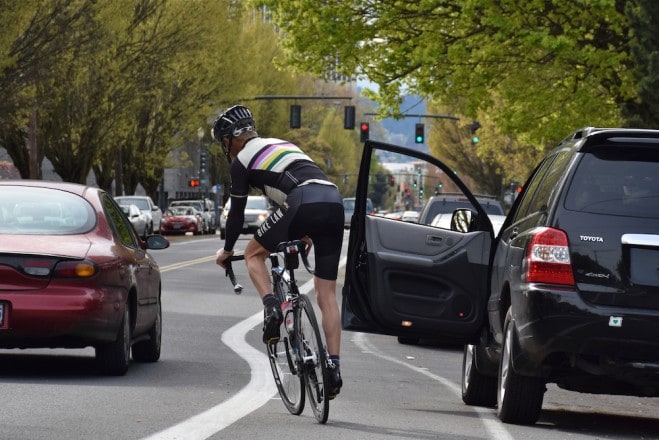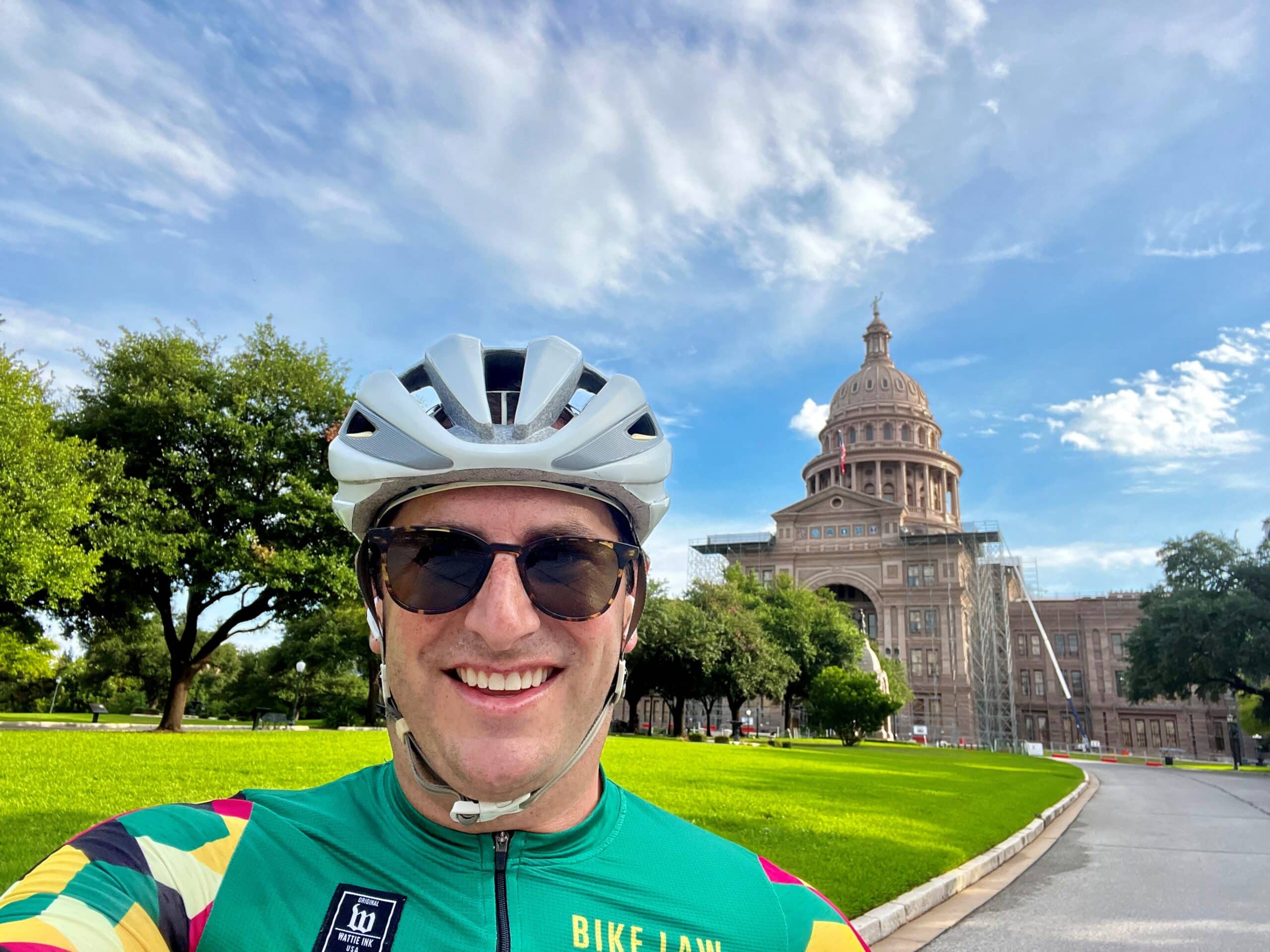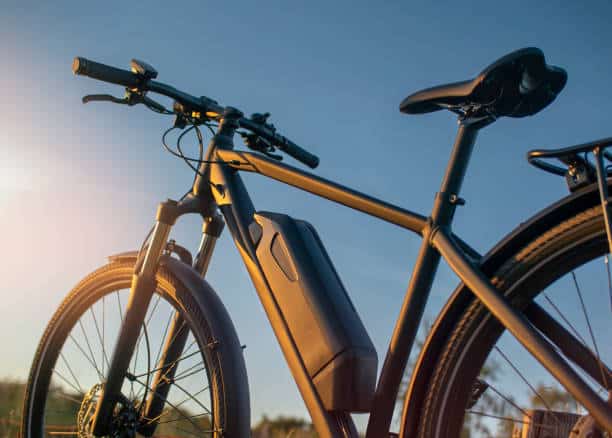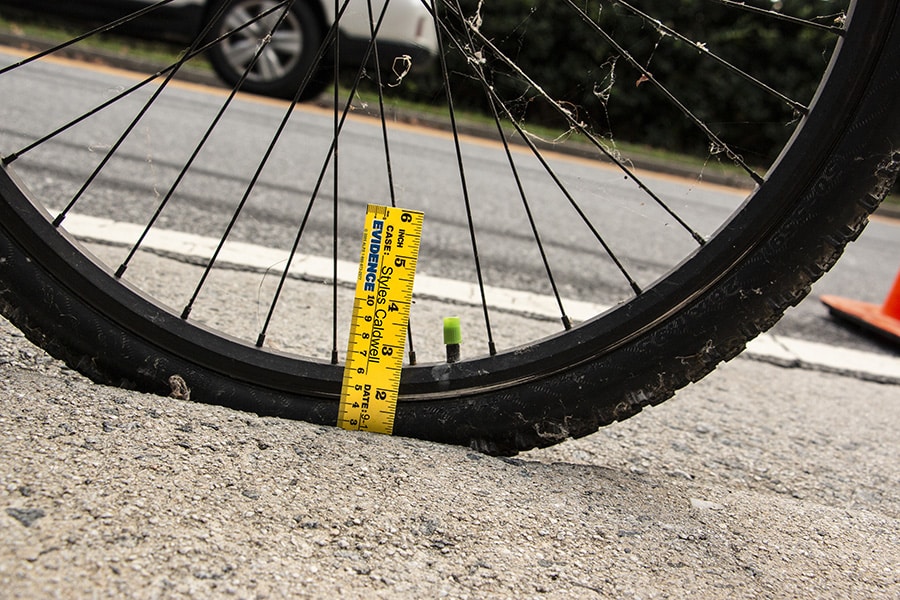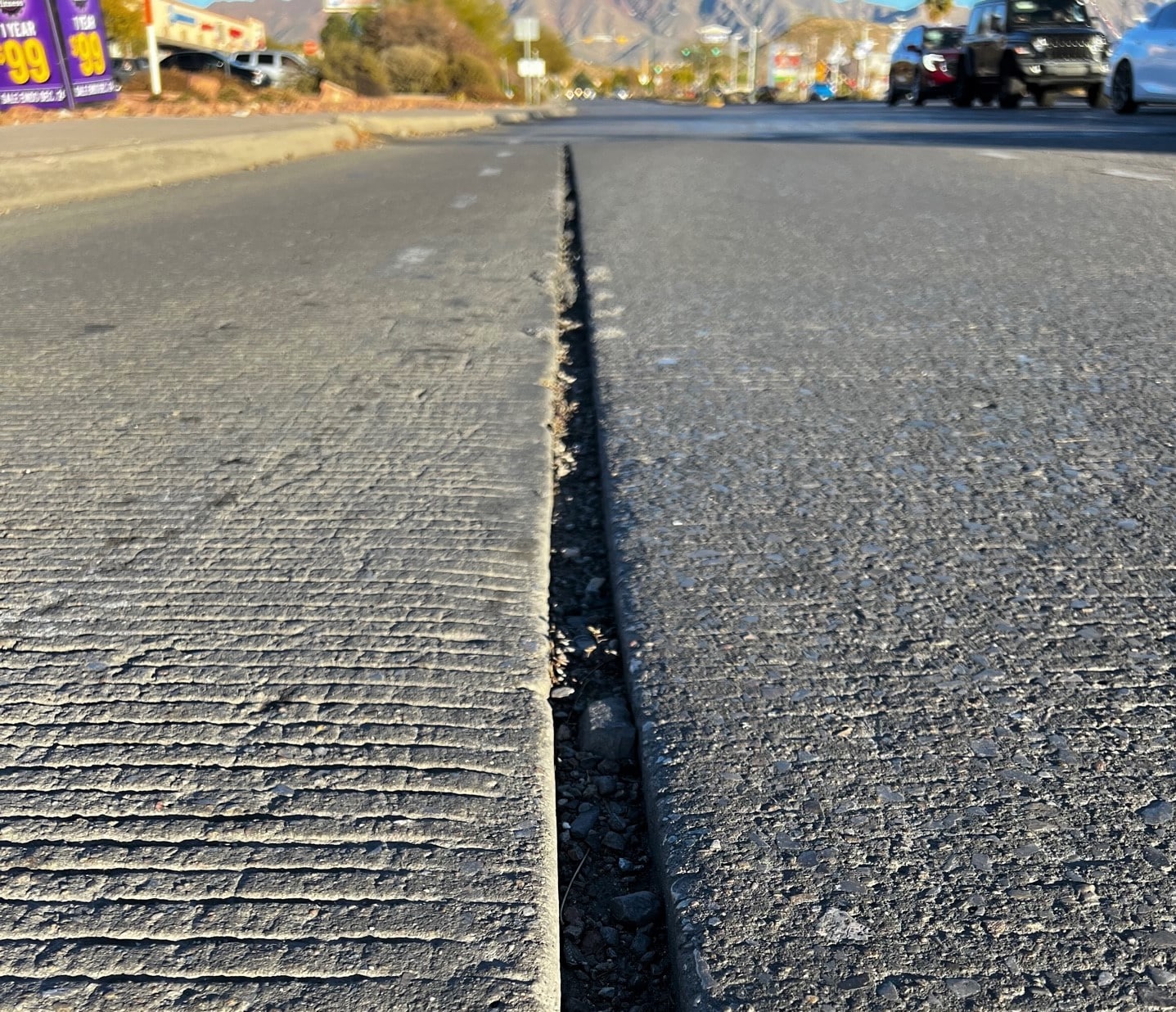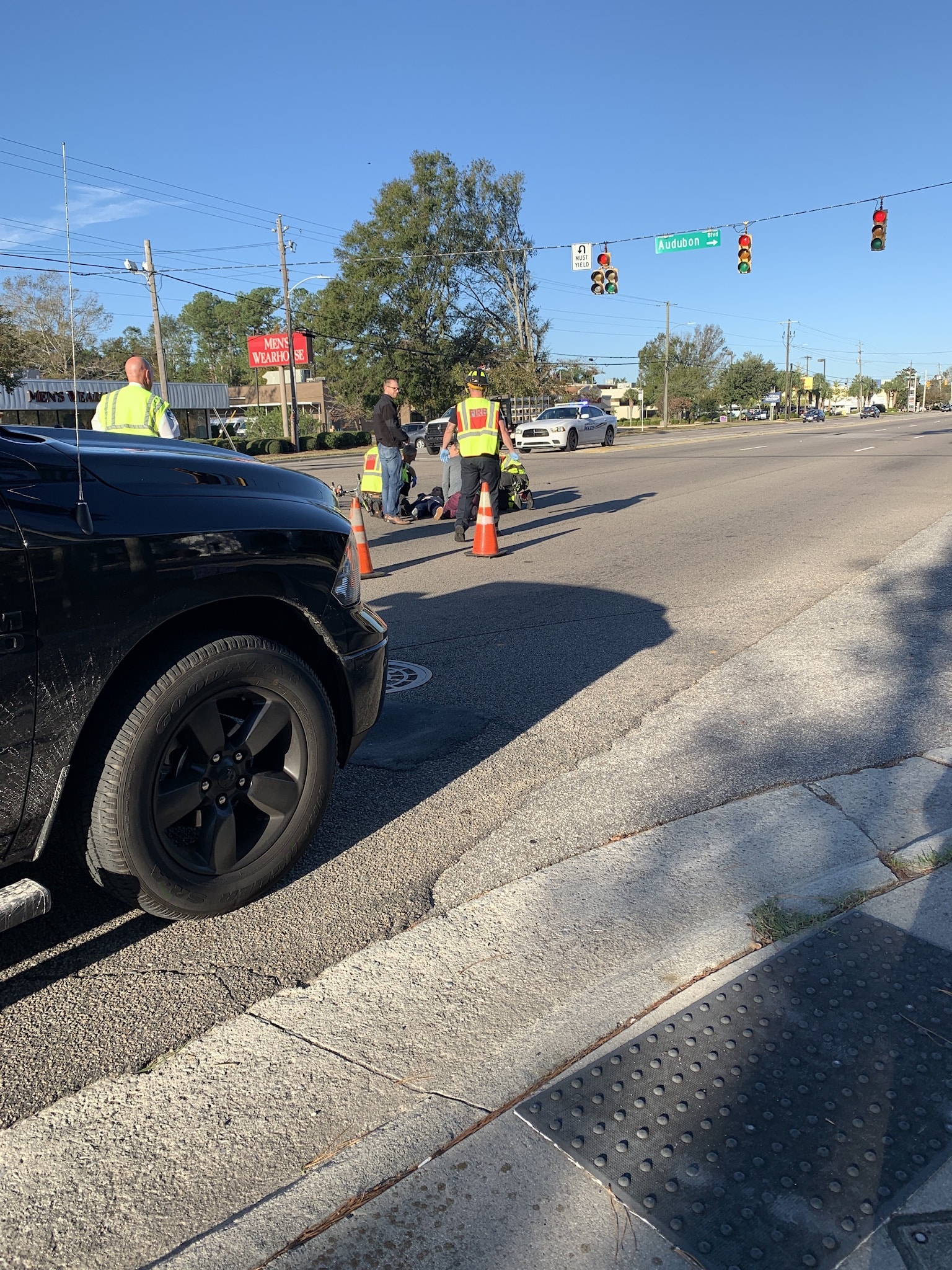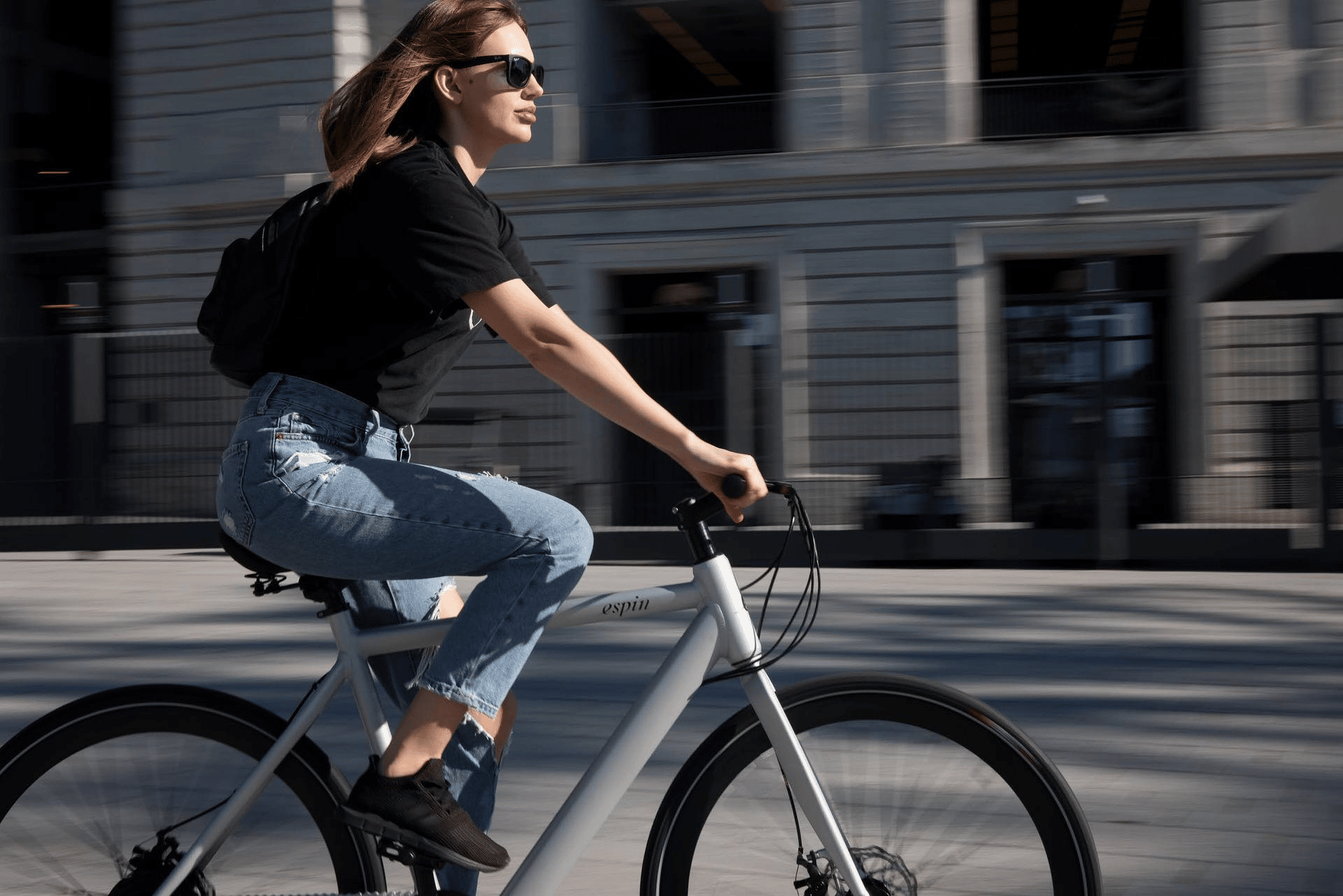Dooring crashes. You know the danger if you live in any U.S. or Canadian city where older roads have been retrofitted with bike lanes. Those bike facilities are often shoehorned into the space next to car parking. When car passengers open their door without looking, they can hit passing bikers.
Here’s how Daniel Flanzig, a member of the Bike Law network in New York, describes dooring accidents:
The “door zone” is the space of 2-4 feet adjacent to parallel parked or stopped cars. While cycling in the “door zone,” a cyclist can suffer a severe injury or even death if a door is suddenly opened into their path of travel. “Doorings” are all too common in New York and make up a large percentage of our cycling crash practice.
Frequency of Dooring Incidents
As Daniel, notes, injuries and fatalities from dooring crashes happen all too frequently. These accidents often make the news, and attorneys in the Bike Law network are regularly contacted for their unique perspectives.
In a news story in the New York Post, City cyclists injured or killed when ‘doored’ by careless drivers, Flanzig said half of his bike crash cases involved dooring. Many of those cases arose as the city pushed to become more bike-friendly and Citi Bike launched its bike sharing program. Flanzig commented that ridership numbers were rapidly outstripping the city’s education efforts:
“The population of cyclists in the city is growing, but the awareness of this dangerous act of opening a door into traffic is not.”
Across the country, it’s not clear exactly how many dooring incidents there are. Brian Weiss, a member of the Bike Law network in Colorado, described why that’s the case:
“Surprisingly, bike crashes that were caused by dooring are not really tracked by any state transportation departments. There are a few recent very isolated surveys. In Illinois, one state that does track bike crashes caused by dooring, the data collected in Chicago alone is shocking. In Chicago, one in five bike crashes were caused by a dooring incident.”
Tougher Penalties for Doorings
There are laws on the books in many states to prohibit doorings. For instance, New York State and New York City have specific laws to prevent doorings, Charlie says. Brian’s post on doorings cites Colorado laws. Louisiana also has a dooring law, notes New Orleans attorney Charlie Thomas, a member of the Bike Law network in Lousiana. Here’s what Charlie says in his blog post on Louisiana’s dooring law:
“Louisiana requires that no person open any door of a motor vehicle located on a highway without first taking precaution to ensure that this action does not interfere with the movement of traffic or endanger any other person or vehicle. In addition, no person shall leave open any door of a motor vehicle located on a highway for a period of time longer than necessary to load or unload passengers. Source: La. Rev. Stat. Ann. §32:283.”
Anti-dooring laws are one approach; penalties for doorings is another. In a Toronto Star article, Flanzig said he favored stiffer fines for dooring incidents in New York and Ontario. Anti-dooring laws don’t stop dooring crashes, he said, but they help when cyclists pursue a legal action over their injuries.
“I don’t think it’s actually ever been a deterrent, but I think it works very, very well when I have a civil claim.”
Legal Action Over Dooring Crashes
As Daniel notes, dooring crashes often lead to legal action against motorists, including cab operators. Daniel has been involved in several legal cases involving dooring incidents. So, too, have Brendan Kevinides and Jim Freeman, members of the Bike Law network in Illinois. Brendan says he and Jim have “handled many, many of these.” Brendan says Chicago motorists often try to deny liability for the dooring crash — and they may even try to charge cyclists for any damage to their cars.
Brendan has written blog posts about two cases where motorists took the low road after a dooring incident. Brendan describes the absurd lengths to which a driver went to deny that he doored a woman riding in a Chicago bike lane.
“A video, the photos of the car and the significant bruising to the top of the cyclist’s right arm and shoulder all pointed to the indisputable fact that she had been doored by the driver of the Volvo from her right side. I confronted the Defendant driver with all of this evidence during his deposition. He continued to deny his involvement.”
The driver’s insurance company eventually settled when they “finally recognized they were fighting a no-win battle,” Brendan said.
Battle Over Illinois Law
Those are not the only legal battles Brendan and Jim are fighting when it comes to doorings in Chicago. A state law that it is intended to keep motorcycles from using the shoulder as a travel lane has been used to hold cyclists at fault when they pass on the right. Jim didn’t mince words about that outlandish application of the law in a Streetsblog Chicago post:
“This is one of the dumber laws that’s applied to bicyclists.”
Brendan agreed with Jim’s assessment in the same blog post:
“If this section is applied to bicycles, it would completely turn the whole concept of ‘share the road’ on its head. What would happen if bicycles were not allowed to travel along the right, or pass along the right?”
Strategies For Preventing Dooring Crashes
Back in Canada, the Toronto Star has gotten serious about its role in protecting cyclists. The paper published a thoughtful article on the topic: How to avoid getting ‘doored’ on your bicycle. It’s worth a read for several strategies that motorists and cyclists can follow, including:
“Treat taxis like landmines. If a cab is slowing down or parked, you can bet a door’s about to pop open.”
Patrick Brown, a member of the Bike Law network in Canada is quoted in that article. He reminds drivers that cyclists are among the most vulnerable road users. “It would be great if the government added increased penalties whenever a cyclist or pedestrian are hit by a car, Patrick says. “If you’re near these people, a small bump could kill them.”
Bob’s Advice: Don’t Play Russian Roulette
Bob Mionske, a Bike Law member in Oregon and a regular contributor to Velo News, has devoted a column to dooring. His take on the problem?
“The best advice is to avoid the door zone entirely, and many cyclists follow this decree as it isn’t always possible to verify whether parked vehicles have occupants. Flying along in the DZ is really playing Russian Roulette.”
Mionske says it’s important that cyclists understand they aren’t necessarily confined to the bike lane.
“Some police officers mistakenly believe the law requires cyclists to ride as close to the right as possible. In reality, it dictates that cyclists do so only to the extent it’s safe. Most states have a law that requires cyclist to ride as far to the right as is ‘practicable.’ ‘Practicable’ does not mean ‘possible.’ I would replace that adjective with the phrase ‘as is safe.’ And riding in the DZ is NOT safe.”
However, Bob notes that some states have prejudicial mandatory bike lane usage laws. Is your state one of them? You can check the list here.
After A Dooring Accident
What should you do if you’re involved in a dooring incident? Brian, with Bike Law Colorado, sent along this advice:
“If you are doored, make sure to take your time and examine your injuries. Many times cyclists will be full of adrenaline or disoriented and won’t be aware of injuries until leaving the scene. Make sure you contact the police, seek immediate medical attention, and get the accident information before leaving the scene. When you are able to get the names of witnesses, the name of the driver and or occupants and their insurance and license information if that information is not taken by the police.” If you have been injured as a result of being car doored, you do have rights. Consult with an experienced Bike Law attorney as soon as possible.”
If you’re an urban cyclist, please keep the danger of dooring incidents in mind as you ride on the many tight bike lanes that have been installed. And as Bob points out, remember that you can make use of the full travel lane when it’s safer to do so.



